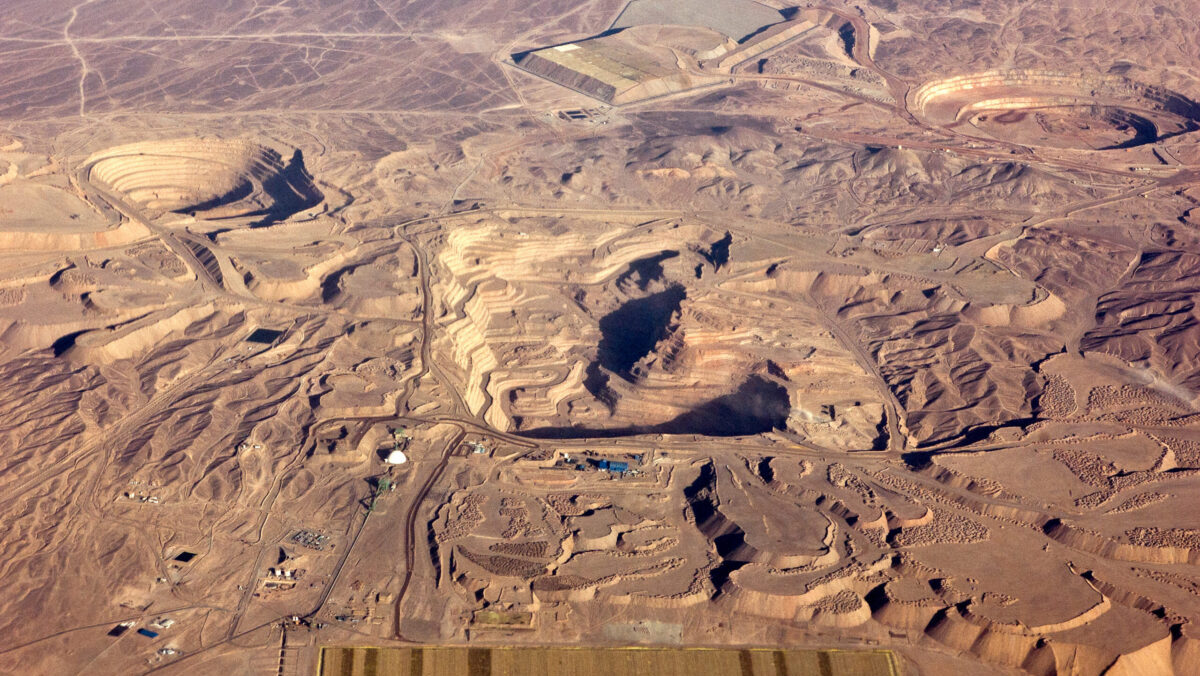Ground Breakers: Copper is now worth more than coal to BHP, but can it keep growing amid headwinds?

BHP's Escondida is the biggest copper mine in the world. Pic: gerardprins.com/Moment Open via Getty Images
- BHP’s results show copper overtook coal in its earnings mix in FY23 as the miner pivots to ‘future facing commodities’
- But it faces big challenges maintaining output from its Escondida mine in Chile in the latter part of the decade, just as demand ramps up
- RBC says BHP’s capex and cost guidance could disappoint investors
BHP’s top brass have big plans to refocus copper at the centre of their business, as the future facing commodity took a major step by replacing coal as the second largest earner in the Big Australian’s portfolio.
Iron ore, the world’s largest mining commodity market, continued to be the mainstay, contributing almost 60% of its US$28 billion earnings haul in a year that saw BHP suffer a 31% earnings hit on lower commodity prices and inflationary pressures.
It was not unlike its peers in that regard. But one big factor was a near halving in earnings from met and thermal coal.
Dropping to US$5b, they are now below copper (US$6.7b) into third place in the world’s biggest miner’s portfolio, with nickel making up a tiny additional chunk.
But, like peers such as Chile’s underwater State-owned miner Codelco, which has just had its third management change in a year, the path to growing its copper business remains a winding one.
Located in Chile, BHP is the majority owner and operator of the Escondida mine, the world’s largest copper producing orebody.
BHP sees output lifting across its business from 1.57Mt in FY22 to 1.72Mt last year and again to between 1.72-1.91Mt next year, virtually all of that growth from the OZ Minerals assets in South Australia picked up in a recent $9.6 billion takeover.
At Escondida, copper production rose 5% to 1.055Mt in FY23 at a 17% cost lift to US$1.40/lb.
It is expected to rise again to 1.08-1.18Mt at US$1.40-1.70/lb in FY24, with medium term output expected to grow further to 1.2-1.3Mt at US$1.30-1.60/lb in FY25 and FY26.
BUT, BHP is facing a big drop in concentrator feed grades by 2027. That means studies have been kicked off to avoid a big decline just as the mining giant expects a big run in copper demand from the energy transition that could send prices rising as supply struggles to meet demand from EVs, poles and wires and renewables.
“Over the next 18 months, Escondida will complete a number of strategic studies into options to offset the impact in the decline of concentrator feed grade which is expected from FY27,” BHP flagged.
“These options include the potential for a new concentrator to replace the current Los Colorados facility and the application of one or more leaching technologies to improve recoveries and unlock primary sulphide resources in the cathode process.
“We expect costs associated with the studies, which are captured as operating costs, to increase to ~US$140m per year in both FY24 and FY25, from ~US$60m in FY23.”
SA a 500,000tpa province
Capex guidance is also expected to lift as BHP’s bid to decarbonise, build new mines and pivot to assets in copper and nickel progresses.
It has been upped from US$9b (up from a touch over US$7b this year) to US$10b for FY24, with medium term guidance of US$11b.
That could included a quicker ramp up for the second stage of its Jansen potash project in Canada, but RBC’s Tyler Broda and Kaan Peker say the risk of major capital at Escondida is also increasing.
“We think this increases the chance of major capital investment and Escondida studies are expected over the next 18 months. We would expect consensus medium-term expectations for Escondida to fall on today’s outlook statement,” they wrote in a note today.
“The higher capex and weaker medium term expectations for Escondida are likely to act as a drag on the shares today.”
BHP remains bullish on its growth potential in copper, and particularly South Australia, where CEO Mike Henry told media the company sees a 500,000tpa copper province emerging. It runs the Olympic Dam mine and smelter alongside OZ’s Prominent Hill and Carrapateena mines, while the large Oak Dam discovery down the road from Olympic Dam looms as a potential multi-billion dollar expansion option.
“The acquisition of OZ Minerals, that gives us a potential strong opportunity around a new copper basin in South Australian and as we’ve seen in iron ore in Western Australia, as we see at coal up in Queensland, when we have a number of operations in close proximity to each other with shared infrastructure, that opens up a whole new front of optionality,” Henry said.
“That’s what we’re hoping for or aspire to in South Australia as well. The settings are right. There’s potential here for us to grow the production base there to over 500,000 tonnes per annum of copper cathode.
“And then of course, we’ve got things that we’re doing around increasing our investment in greenfields exploration. You’ll note that we have found two new deposits in recent years being Oak Dam in South Australia, that will be part of that basin that I mentioned, as well as Ocelot across in the US.
“So the way that we’re going about exploration is paying dividends.”
Iron ore cost support at US$80-100/t
Another tricky aspect of BHP’s results was the fact costs will remain sticky, especially when it comes to labour.
“In regards to cost guidance, this is generally inline for Escondida at $1.40-$1.70/lb (on a weaker CLP of 811) with RBC at $1.50/lb (but the FY27 onward period will likely indicate higher costs),” RBC’s Peker and Broda say.
“In WAIO the costs are guided to $17.40-$18.90/t which remains competitive, albeit not as strong as RBCe $17.03/t. Medium-term cost guidance remains at $17/t. BMA costs guided to FY24 $95-$105 are also higher than RBC $93/t.”
Along with a waning Chinese economy and potential production curbs in the second half of 2023 in China, what impact will this have on the health of BHP’s iron ore business, it’s golden goose?
Henry acknowledges production curbs are a possibility, but says cost inflation — pegged by BHP across its operations at 10% last year — could well support incumbents with large margins like themselves.
“I think there’s actually two factors at play. One is overall what happens with steel and therefore overall impact on iron ore demand, but we also have to keep in mind that inflation has been running at pretty high levels,” he said.
“We’ve contained inflation at our iron ore cost of 5% in terms of the unit cost but we know others that run at higher levels.
“Hence my point earlier that we’ve kind of doubled our lead. The implication of that, because that inflation has been global, is that the marginal cost of production for iron ore as well as other commodities, has gone up.
“All other things being equal, that means a cushion kind of arises for iron ore at higher levels and other commodities at higher levels than it would in the past.
“I think in the case of iron ore we’ve spoken about at US$80-100 is kind of the window where we see that cushion kick in. Obviously very difficult to predict the specifics and it will come back to how sharp is the pullback in demand and so on.”
BHP (ASX:BHP) share price today

UNLOCK INSIGHTS
Discover the untold stories of emerging ASX stocks.
Daily news and expert analysis, it's free to subscribe.
By proceeding, you confirm you understand that we handle personal information in accordance with our Privacy Policy.








